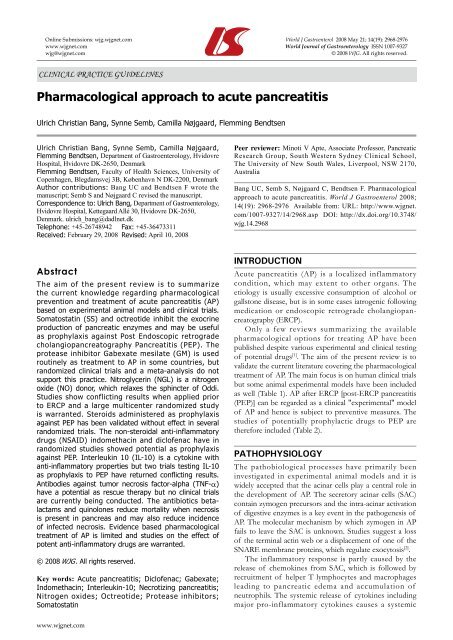Tradition or evidence based practice? - World Journal of ...
Tradition or evidence based practice? - World Journal of ...
Tradition or evidence based practice? - World Journal of ...
Create successful ePaper yourself
Turn your PDF publications into a flip-book with our unique Google optimized e-Paper software.
Online Submissions: wjg.wjgnet.com W<strong>or</strong>ld J Gastroenterol 2008 May 21; 14(19): 2968-2976<br />
www.wjgnet.com W<strong>or</strong>ld <strong>Journal</strong> <strong>of</strong> Gastroenterology ISSN 1007-9327<br />
wjg@wjgnet.com © 2008 WJG. All rights reserved.<br />
CLINICAL PRACTICE GUIDELINES<br />
Pharmacological approach to acute pancreatitis<br />
Ulrich Christian Bang, Synne Semb, Camilla Nøjgaard, Flemming Bendtsen<br />
Ulrich Christian Bang, Synne Semb, Camilla Nøjgaard,<br />
Flemming Bendtsen, Department <strong>of</strong> Gastroenterology, Hvidovre<br />
Hospital, Hvidovre DK-2650, Denmark<br />
Flemming Bendtsen, Faculty <strong>of</strong> Health Sciences, University <strong>of</strong><br />
Copenhagen, Blegdamsvej 3B, København N DK-2200, Denmark<br />
Auth<strong>or</strong> contributions: Bang UC and Bendtsen F wrote the<br />
manuscript; Semb S and Nøjgaard C revised the manuscript.<br />
C<strong>or</strong>respondence to: Ulrich Bang, Department <strong>of</strong> Gastroenterology,<br />
Hvidovre Hospital, Kettegaard Allé 30, Hvidovre DK-2650,<br />
Denmark. ulrich_bang@dadlnet.dk<br />
Telephone: +45-26748942 Fax: +45-36473311<br />
Received: February 29, 2008 Revised: April 10, 2008<br />
Abstract<br />
The aim <strong>of</strong> the present review is to summarize<br />
the current knowledge regarding pharmacological<br />
prevention and treatment <strong>of</strong> acute pancreatitis (AP)<br />
<strong>based</strong> on experimental animal models and clinical trials.<br />
Somatostatin (SS) and octreotide inhibit the exocrine<br />
production <strong>of</strong> pancreatic enzymes and may be useful<br />
as prophylaxis against Post Endoscopic retrograde<br />
cholangiopancreatography Pancreatitis (PEP). The<br />
protease inhibit<strong>or</strong> Gabexate mesilate (GM) is used<br />
routinely as treatment to AP in some countries, but<br />
randomized clinical trials and a meta-analysis do not<br />
supp<strong>or</strong>t this <strong>practice</strong>. Nitroglycerin (NGL) is a nitrogen<br />
oxide (NO) don<strong>or</strong>, which relaxes the sphincter <strong>of</strong> Oddi.<br />
Studies show conflicting results when applied pri<strong>or</strong><br />
to ERCP and a large multicenter randomized study<br />
is warranted. Steroids administered as prophylaxis<br />
against PEP has been validated without effect in several<br />
randomized trials. The non-steroidal anti-inflammat<strong>or</strong>y<br />
drugs (NSAID) indomethacin and dicl<strong>of</strong>enac have in<br />
randomized studies showed potential as prophylaxis<br />
against PEP. Interleukin 10 (IL-10) is a cytokine with<br />
anti-inflammat<strong>or</strong>y properties but two trials testing IL-10<br />
as prophylaxis to PEP have returned conflicting results.<br />
Antibodies against tum<strong>or</strong> necrosis fact<strong>or</strong>-alpha (TNF-α)<br />
have a potential as rescue therapy but no clinical trials<br />
are currently being conducted. The antibiotics betalactams<br />
and quinolones reduce m<strong>or</strong>tality when necrosis<br />
is present in pancreas and may also reduce incidence<br />
<strong>of</strong> infected necrosis. Evidence <strong>based</strong> pharmacological<br />
treatment <strong>of</strong> AP is limited and studies on the effect <strong>of</strong><br />
potent anti-inflammat<strong>or</strong>y drugs are warranted.<br />
© 2008 WJG . All rights reserved.<br />
Key w<strong>or</strong>ds: Acute pancreatitis; Dicl<strong>of</strong>enac; Gabexate;<br />
Indomethacin; Interleukin-10; Necrotizing pancreatitis;<br />
Nitrogen oxides; Octreotide; Protease inhibit<strong>or</strong>s;<br />
Somatostatin<br />
www.wjgnet.com<br />
Peer reviewer: Minoti V Apte, Associate Pr<strong>of</strong>ess<strong>or</strong>, Pancreatic<br />
Research Group, South Western Sydney Clinical School,<br />
The University <strong>of</strong> New South Wales, Liverpool, NSW 2170,<br />
Australia<br />
Bang UC, Semb S, Nøjgaard C, Bendtsen F. Pharmacological<br />
approach to acute pancreatitis. W<strong>or</strong>ld J Gastroenterol 2008;<br />
14(19): 2968-2976 Available from: URL: http://www.wjgnet.<br />
com/1007-9327/14/2968.asp DOI: http://dx.doi.<strong>or</strong>g/10.3748/<br />
wjg.14.2968<br />
INTRODUCTION<br />
Acute pancreatitis (AP) is a localized inflammat<strong>or</strong>y<br />
condition, which may extent to other <strong>or</strong>gans. The<br />
etiology is usually excessive consumption <strong>of</strong> alcohol <strong>or</strong><br />
gallstone disease, but is in some cases iatrogenic following<br />
medication <strong>or</strong> endoscopic retrograde cholangiopancreatography<br />
(ERCP).<br />
Only a few reviews summarizing the available<br />
pharmacological options f<strong>or</strong> treating AP have been<br />
published despite various experimental and clinical testing<br />
<strong>of</strong> potential drugs [1] . The aim <strong>of</strong> the present review is to<br />
validate the current literature covering the pharmacological<br />
treatment <strong>of</strong> AP. The main focus is on human clinical trials<br />
but some animal experimental models have been included<br />
as well (Table 1). AP after ERCP [post-ERCP pancreatitis<br />
(PEP)] can be regarded as a clinical "experimental" model<br />
<strong>of</strong> AP and hence is subject to preventive measures. The<br />
studies <strong>of</strong> potentially prophylactic drugs to PEP are<br />
theref<strong>or</strong>e included (Table 2).<br />
PATHOPHYSIOLOGY<br />
The pathobiological processes have primarily been<br />
investigated in experimental animal models and it is<br />
widely accepted that the acinar cells play a central role in<br />
the development <strong>of</strong> AP. The secret<strong>or</strong>y acinar cells (SAC)<br />
contain zymogen precurs<strong>or</strong>s and the intra-acinar activation<br />
<strong>of</strong> digestive enzymes is a key event in the pathogenesis <strong>of</strong><br />
AP. The molecular mechanism by which zymogen in AP<br />
fails to leave the SAC is unknown. Studies suggest a loss<br />
<strong>of</strong> the terminal actin web <strong>or</strong> a displacement <strong>of</strong> one <strong>of</strong> the<br />
SNARE membrane proteins, which regulate exocytosis [2] .<br />
The inflammat<strong>or</strong>y response is partly caused by the<br />
release <strong>of</strong> chemokines from SAC, which is followed by<br />
recruitment <strong>of</strong> helper T lymphocytes and macrophages<br />
leading to pancreatic edema and accumulation <strong>of</strong><br />
neutrophils. The systemic release <strong>of</strong> cytokines including<br />
maj<strong>or</strong> pro-inflammat<strong>or</strong>y cytokines causes a systemic

















